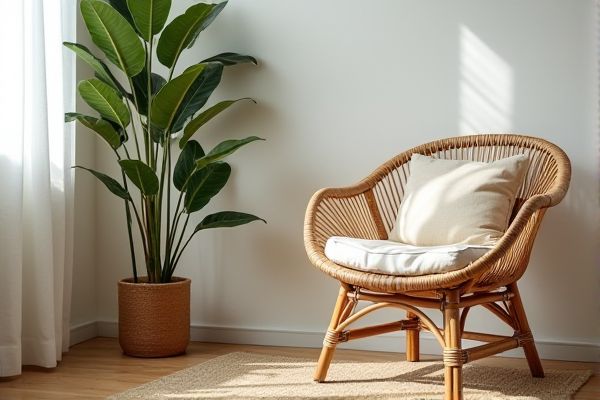
Rattan chairs offer lightweight durability and a natural, flexible weave that adapts comfortably to your body, while bamboo chairs are known for their sturdiness and eco-friendly qualities with a more rigid structure. Explore the following comparison to discover which chair suits your style and needs best.
Table of Comparison
| Feature | Rattan Chair | Bamboo Chair |
|---|---|---|
| Material | Natural rattan vine | Bamboo stalks |
| Weight | Lightweight | Heavier |
| Durability | Moderate, prone to weather damage | High, strong and weather-resistant |
| Flexibility | Highly flexible for weaving | Less flexible, rigid structure |
| Appearance | Woven, intricate design | Sleek, natural bamboo nodes visible |
| Maintenance | Requires regular dusting and protection | Low maintenance, easy to clean |
| Eco-friendliness | Renewable, biodegradable | Highly sustainable and fast-growing |
| Cost | Generally moderate | Varies, often economical |
| Ideal Use | Indoor and covered outdoor spaces | Indoor and outdoor use |
Introduction to Rattan and Bamboo Chairs
Rattan chairs, crafted from the durable, flexible stems of rattan palms, offer lightweight strength and natural elegance, making them ideal for indoor and outdoor furniture. Bamboo chairs are constructed from fast-growing bamboo stalks known for their sustainability, robust structure, and distinctive grain patterns, providing eco-friendly seating options. Both materials emphasize renewable resources, but rattan's vine-like texture contrasts with bamboo's solid, woody composition, influencing design and durability.
Material Origins: Rattan vs Bamboo
Rattan originates from the climbing palms of the Calamus genus found predominantly in Southeast Asia, known for its flexible, durable stems ideal for weaving furniture. Bamboo, a fast-growing grass native to various parts of Asia, Africa, and the Americas, features hollow, sturdy stalks that provide natural strength and lightweight properties. Choosing between rattan and bamboo chairs depends on your preference for the material's origin and structural characteristics, as rattan offers more pliability while bamboo provides a solid yet lightweight frame.
Durability and Strength Comparison
Rattan chairs feature a dense, fibrous structure that offers excellent flexibility and moderate durability, making them resistant to cracking under pressure. Bamboo chairs boast superior strength due to the natural hardness and lignin content in bamboo stalks, resulting in highly durable furniture that withstands heavy use and environmental stress. While rattan provides a lightweight and resilient option, bamboo chairs generally surpass in load-bearing capacity and long-term structural integrity.
Aesthetic Differences in Design
Rattan chairs often feature intricate woven patterns and a glossy finish that exudes a rustic yet elegant charm, making them ideal for cozy, traditional spaces. Bamboo chairs typically showcase a more minimalist and contemporary design with clean lines and a natural matte texture, perfect for modern and eco-friendly interiors. Your choice between the two should reflect the aesthetic ambiance you want to create, balancing warmth and sophistication with simplicity and sustainability.
Comfort and Ergonomics
Rattan chairs offer superior comfort and ergonomics due to their flexible yet sturdy weave that conforms to the body's natural curves, providing excellent lumbar support. Bamboo chairs, while durable, tend to have a more rigid structure that may require additional cushions for prolonged comfort. Ergonomically, rattan's natural elasticity promotes better airflow and reduces pressure points, enhancing overall seating experience compared to the harder surface of bamboo.
Maintenance and Care Requirements
Rattan chairs require regular dusting and occasional application of furniture polish or oil to prevent drying and cracking, while bamboo chairs need to be kept dry and cleaned with a damp cloth to avoid mold and mildew growth. Both materials benefit from occasional rinsing with mild soapy water but should be dried thoroughly to maintain durability. Proper maintenance extends the lifespan of rattan and bamboo furniture, preserving their natural beauty and structural integrity.
Environmental Impact and Sustainability
Rattan chairs have a lower environmental footprint due to the rapid growth rate of rattan vines, which regenerate quickly without requiring deforestation, making them highly sustainable. Bamboo chairs, although also eco-friendly, involve cutting down bamboo stalks that take a few years to mature, yet bamboo's natural strength and fast growth still support sustainability. Both materials promote biodegradability and reduced carbon emissions compared to plastic or metal furniture, but rattan's flexibility and renewable harvesting process often position it as the more environmentally sustainable option.
Price and Affordability Analysis
Rattan chairs typically come at a higher price point due to the intricate weaving process and durability of natural rattan, making them a long-term investment for quality seating. Bamboo chairs are generally more affordable, offering a cost-effective option without compromising basic strength and sustainability. Your choice depends on budget constraints and preference for either premium craftsmanship or budget-friendly eco-friendly furniture.
Indoor vs Outdoor Usability
Rattan chairs excel in indoor settings due to their lightweight structure and elegant appearance but require protection from prolonged moisture exposure to prevent damage. Bamboo chairs offer superior durability and resistance to outdoor elements, making them ideal for patios and gardens where humidity and sunlight are factors. Choosing between rattan and bamboo depends on the specific indoor or outdoor usage requirements, with bamboo favored for rugged environments and rattan for controlled indoor atmospheres.
Choosing Between Rattan and Bamboo Chairs
Choosing between rattan and bamboo chairs depends on durability, style, and maintenance needs. Rattan chairs offer flexibility and a rich, woven texture, making them ideal for indoor use with moderate wear, while bamboo chairs provide superior strength and resistance to outdoor conditions with a natural, smooth finish. Consider factors like environmental exposure, aesthetic preference, and upkeep requirements to determine the best option for your space.
 homyna.com
homyna.com